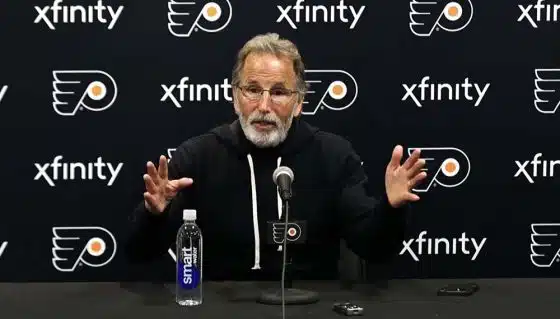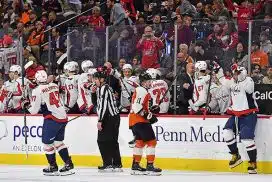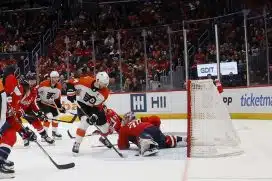By Kevin Durso, Sports Talk Philly editor
The Flyers played the first half of Thursday’s game against the Bruins in similar fashion to Monday’s blowout loss to Buffalo. A sharper Carter Hart was the difference in the game to that point, piling up the saves and making difficult ones look easy as the game remained scoreless.
As the period progressed, the Flyers got better and used that to get two goals to take a 2-0 lead to the third. It looked like it was all coming together for the Flyers to weather another storm.
Then the first three minutes of the third period happened. The Flyers were right back to where they were at the start of the game, and the Bruins were breaking through. Just when it appeared the dust settled and the Flyers were back in the lead again, a power play turned the tide again for the Bruins.
The Flyers managed to get a point in Thursday’s game with a late power-play goal that tied things up and forced overtime and the eventual shootout, but it is a relatively lucky point for the Flyers to earn, given how the game played out. It could have easily been two points…and it could have easily been no points.
Here are five takeaways from Thursday’s shootout loss for the Flyers.
1. Power Play Comes Through
Let’s start this on a positive note: the Flyers power play was 2-for-5 in the game. On one such power play, the maintained possession as it expired led to another goal, so essentially, the Flyers scored three goals during this game on or in the seconds after a power play.
There are some signs that the power play is starting to click. Claude Giroux got on the board with a goal from his familiar spot on the power play. James van Riemsdyk scored twice, once on the power play and once seconds after, from his usual spot on the ice, right in front of the net.
The second power-play goal was especially huge. The Flyers found a way to get the game tied back up in a spot where they could have easily let it slip away and been forced to get the goalie out. Instead, that goal is what likely saved the Flyers and got them a point in the standings. After hitting a small slump earlier in the week, they seem to have found some rhythm, certainly a good sign moving forward.
2. Hart’s Up-and-Down Night
It was certainly an up-and-down night for Carter Hart in goal. It started with plenty of ups. He was excellent in the first period, stopping 14 shots, and as the Flyers started to gain better grasp of the play in the second, he faced only four shots to be up to 18 saves through two periods. He had survived the early barrage and was now settling in.
Then the third period happened. He managed to get the first chance for Jack Studnicka, but the young forward stayed with it and put in his own rebound, left all alone at the front of the net. The next goal by Charlie Coyle was on a rebound turnaround shot. Hart admitted after the game he should have stopped it.
From there, it was hard to see where Hart could have been better. He was left without much of a chance on Nick Ritchie’s tying goal, but somehow managed to get a piece of it as it went into the net. On Brandon Carlo’s point shot, it was a one-timer placed perfectly high to the glove side. Not much of a chance for Hart on that rocket either.
Even the shootout goal he allowed was a masterful work of art, a perfect shot to the top shelf again.
The numbers don’t look outstanding for Hart right now, and that is leaving people wondering if he’s off to a slow start or doesn’t look right. This team has issues far bigger than Carter Hart right now, and if you were watching the first two periods, you would know he is the biggest reason they even got a point in this game at all.
3. Late Game Issues
So what are the issues? Defensive play is a clear liability for this team at the moment. And it goes far beyond the fact that Matt Niskanen is no longer part of the team.
This isn’t about the defenseman position alone. This isn’t about losing players due to injury. This is about a collective defensive effort and getting support from all players on the ice and sticking with a gameplan. It appeared the Flyers were finally getting there during that second period. It was completely night and day from their first-period performance. And now they had a two-goal lead to show for the effort of their goalie and some timely goals. They were in a position to win.
Right out of the gate in the third period, the sloppiness returned. It doesn’t matter who is in control of the puck in the defensive zone. If this team can’t get out of their own way, they won’t go very far. The turnovers were back. The forced passes were back. Making the simple play stopped being the decision made.
Later in the game, these issues popped up as the Flyers chased the play, struggled to clear, and committed numerous turnovers. Getting the lead can be hard enough. The Flyers need to do a better job protecting the lead, especially as the game gets to the later stages.
4. Shots, Shots, Shots
This may be the biggest defensive issue to fix. Again, it is a collective one.
There are games where a team will allow an abundance of shots. Many times, a team that takes a lot of shots will still not be satisfied, because they will have been kept to the outside and not taken much of quality.
Following Thursday’s game, the Flyers have allowed an average of 37.4 shots per game. The only teams to allow more per game are the New Jersey Devils and Vancouver Canucks. But it’s more than just allowing shots. The Flyers have also allowed 144 scoring chances and 63 high-danger scoring chances, both second to only the Canucks.
It’s not that the Flyers are giving up a lot of shots, like the ridiculous 22 they allowed in the third period alone, it’s that they are allowing quality shots to reach their goaltender. They are allowing quality chances that lead to opportunities for teams to take full control of a game, as the Bruins did at several points in the period.
So far in the five games played, the Flyers have allowed 11, 9, 11, 16, and 22 shots in the third period. They have allowed 33 shots or more in each game, including 40 or more in each of the last two games. But up until Thursday, they had allowed just three third period goals, two of them coming in Monday’s loss to Buffalo that was already out of reach. In allowing four third-period goals in this game, this was the first time it really caught up to them.
It’s certainly a struggle and an adjustment playing without Niskanen and having to fill the void of two quality defensive players like Sean Couturier and Phil Myers. But it’s not an excuse. Everyone else needs to be better and find the structure that had the Flyers averaging a league-best 28.7 shots against a season ago.
5. Next Man Up
Coming into this game, it was about the next man up mentality and seeing guys step up. Mark Friedman was playing an overall solid game until he got tangled up with Brad Marchand and fell to the ice, hitting head-first and staying down while bleeding heavily. He was kept out of the rest of the game as a precaution.
Connor Bunnaman was the next man up at forward, and he did a really strong job being disruptive and providing energy on every shift. He fits the fourth-line role really well and brought a lot to the table in this game. He will almost certainly get another chance when these two teams meet again on Saturday night.







